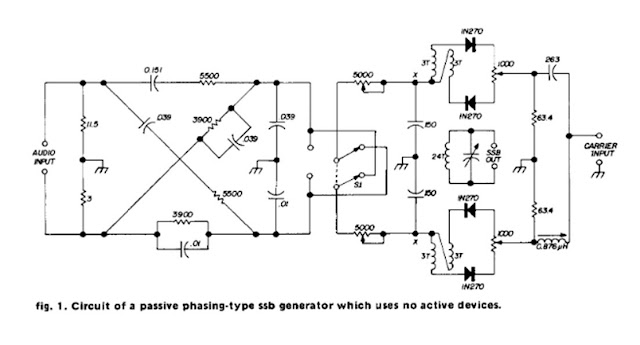Like a Grab Bag of stuff. Some circuits to ponder and piddle with by wasting an evening or two...
I was looking through my Homebrew SDR folder recently and spotted this jewel that I had downloaded about four years ago. Here is a Passive Phasing SSB Generator that uses no active devices.
Just a guess, but maybe somewhere around 20 dB of opposite sideband suppression which is enough to get huge howls from the FLEX and APACHE guys. If you build this, use 0.1% tolerance resistors and caps as these are critical to a 90 degree phase shift for the Audio. The Phasing network is not unlike what is inside of a B&W 2Q4 which is in a metal tube with an octal plug resembling a 6H6 twin diode. The DPDT switch is there to do USB/LSB selection.
Above
a nifty Microphone Amplifier circuit that has a low frequency cutoff and a
flat response out to 20kHz (and beyond). R6, R7 and R8 simulate a 10K
pot and are there to look at outputs at different pot settings. Install a
10K pot if you build this.
The next two photos are how to diode steer circuits so the same circuit can be used both on transmit and receive. From Watkins Johnson when discussing with them using Diodes with MMIC's. They shared that they recommend the 1N3070 because of its excellent RF characteristics.
At $7 each likely you will try for something else like 1N914. I think I bought a bag of 100 for $7 about 15 years ago.
Above is a single MPF-102 40M CW transceiver. This has only 15 parts but looks like a killer to get working. I think N2COR built this but I believe had to make modifications to get it up and running. There are no free lunches!
I built this transmitter but never saw 1 watt even with 13VDC. The VN10KM was very hard to find. If you build this, tack on a W3NQN filter in lieu of the Pi Network. (Oh, already you forgot about the 2nd Harmonic.)
The above transmitter is from GM3OXX in a SPRAT article and noteworthy is there is a pick off point from the BC107 to provide an LO output to the Rx (possibly to some sort of Product Detector).
One issue may be the Zero beating of the signal as I didn't look to see if the Rx had circuitry to shift the LO frequency on Receive. It likely does but I didn't download the Rx portion. A caution to always get all of the data. The BCY70 (PNP) is a keyed DC switch to power on the 2N4427 which used to be a pretty healthy RF device.
Short story is the Oscillator is always running and the Final is keyed. That eliminates some clicks and chirps but does cause what is called a Backwave. I would tack on a W3NQN Filter following the 10nF on the Collector of the 2N4427
Finally a bit of nostalgia. The above photo is of the street in Arnold, Pennsylvania. It sure does look like the inner city of Detroit but this is a town in Western Pennsylvania, about 20 miles north of Pittsburgh. Arnold had a major Glass factory that employed a large segment of the local citizens.
Just a few blocks away was the city of New Kensington, home to one of the first Alcoa plants. Sixty years ago if you had an aluminum pot or pan it mostly likely was made at that plant. They even made aluminum telephone booths there. Both the Glass Factory and Alcoa are long gone!
Up until the 1960's this was a thriving street with the homes and buildings in good order and pride in the neighborhood.
But this photo is a sure sign of the decay of the US Empire. In many ways it is like what is happening in our hobby and in time the guys from Newington, CT, may turn our hobby into something resembling the photo. Caveat Emptor and Cave Canem.
73's
Pete N6QW









